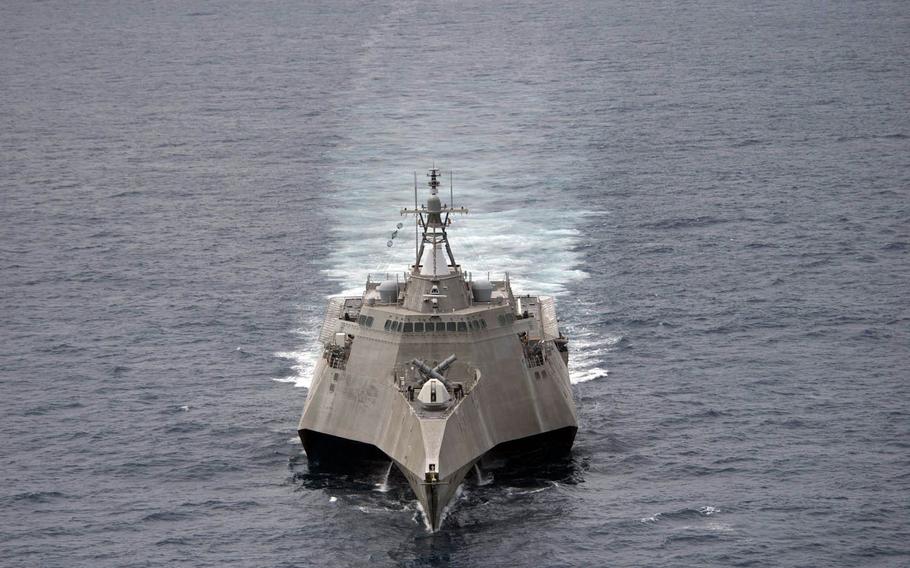
The USS Coronado, a littoral combat ship, conducts drills in the South China Sea, Feb. 1, 2017. (Amy Ressler/U.S. Navy photo)
YOKOSUKA NAVAL BASE, Japan — China is considering maritime law changes that could clash with U.S. Navy views on freedom of navigation in the South China Sea and other international waters.
Revisions to China’s 1984 Maritime and Traffic Safety Law would require foreign ships to request permission to enter “China’s waters,” according to Global Times, an English-language daily newspaper tied to the Chinese Communist Party.
The draft also requires submarines and other submersible boats to surface, fly a flag and report to Chinese authorities, the newspaper reported.
The revisions to the law, announced Tuesday, are still in their formative stages and wouldn’t take effect until 2020, Global Times reported.
The U.S. does not recognize any nation’s right to be notified in advance if a ship is transiting through territorial waters under what international law terms “innocent passage.” The Navy conducts freedom-of-navigation missions throughout the world to uphold the principle.
“Freedom of navigation is absolute, and whether it be commercial shipping or our U.S. Navy, we will practice in international waters and transit international waters as appropriate,” Defense Secretary Jim Mattis told reporters in Tokyo on Feb. 4 after meeting with Japan’s defense minister.
Under innocent passage, ships perform no military operations or survey activities, among other prohibited actions.
Submersible ships are already required to fly a flag and surface in territorial seas under the United Nations Convention on the Law of the Sea, which China has ratified and the U.S. follows as customary law. The UNCLOS passage on submersible boats says nothing about prior notification, though other passages grant nations limited rights to regulate safety within territorial waters.
However, the greatest source of conflict if Beijing moves ahead with its law as drafted likely lies in how it defines “China’s waters.”
China maintains an ambiguous claim to about 90 percent of the South China Sea through markings on a map known as the nine-dash line. The line was ruled noncompliant with UNCLOS by an international tribunal in July, but China has ignored that ruling.
In December, a Chinese ship captured a U.S. unmanned underwater vehicle within view of the USNS Bowditch, while in international waters about 50 miles from the Philippines.
China didn’t return the drone for several days, when the destroyer USS Mustin collected it during a transfer at sea.
Meanwhile, China has constructed several artificial islands in the South China Sea on top of reefs that other nations claim. It has topped the islands with military capable runways, radar and weapons systems.
Artificial islands generate no territorial sea rights under UNCLOS. Nevertheless, China has attempted to warn away Navy ships and others that approach the islands.
While in Tokyo, Mattis accused China of “shredding the trust” of its neighbors with its island-building and attempts at regulating nearby waters.
“We don’t settle [territory] by taking military means and occupying land that is subject to question, to say the least about who actually owns it, or [when it’s] in international waters,” he said.
Yang Cuibai, a Sichuan University law professor, told Global Times that China should take the lead in establishing a legal order in the Yellow, East China and South China seas.
Mattis and several U.S. officials before him have urged China to abide by the maritime legal framework in place, which reconciles disputes through international arbitration.
slavin.erik@stripes.com Twitter: @eslavin_stripes